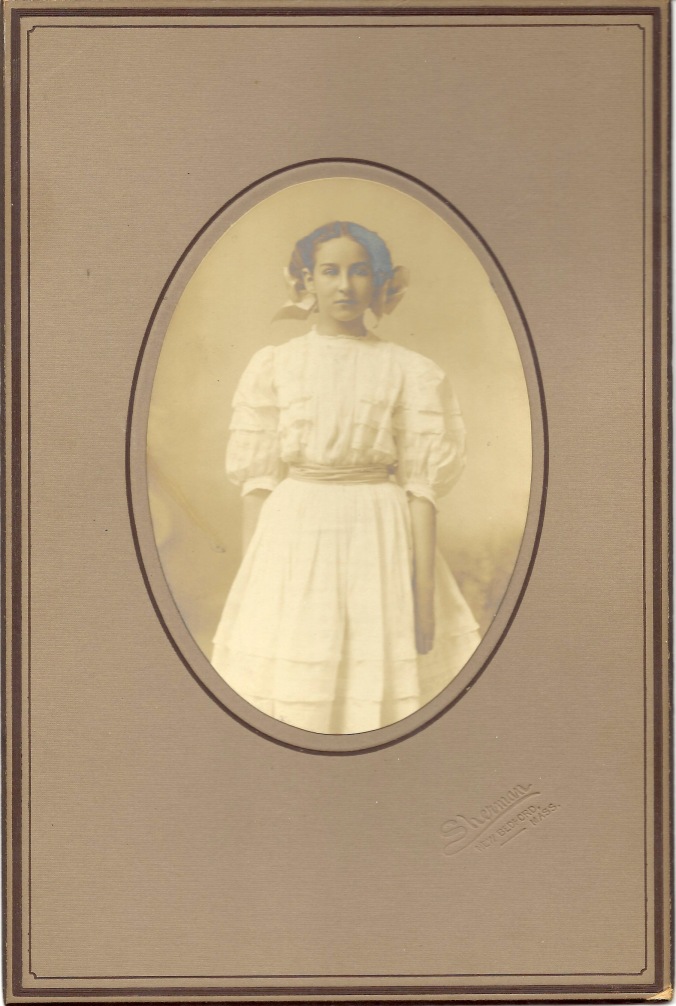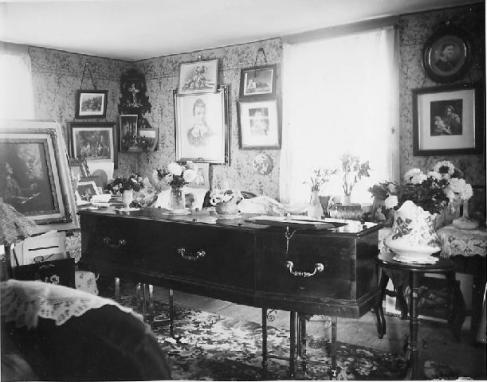James McDonald sat in the wagon with his hands and feet bound and his eyes blindfolded. He could hear the jeers of the 40 or 50 hooded men yelling, “kill him” and “lynch him”. Moments earlier, he had been forced from the house in which he was boarding and stripped of his clothing while someone slathered him with tar and then dumped feathers on him. To an observer, it seemed to be an old fashioned form of public humiliation that one had heard took place in Salem and Boston in the 1760s and 1770s but rarely in the early 20th century.
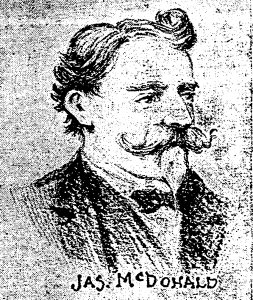
James McDonald, 1902
They were now in the darkness on the side of the road at the Marion-Mattapoisett border when McDonald felt a rope drop around his neck. Someone pulled him up and kicked him off the cart. He felt the rope suddenly grow tight around his neck. He gasped for air as he tried in vain to feel the ground with his feet. It was that moment when Charles Potter, a man that took the most pleasure in witnessing the mob’s work, would later describe as “the best joke of the evening”.
McDonald came to Marion around 1901. At that time Marion was known as “ultra exclusive” and a place that had “prided itself on its quiet refinement and culture”. It was a summer resort to famous notables such as writer Richard Harding Davis, actress Ethel Barrymore and politicians such as President Grover Cleveland and Massachusetts Attorney General Hosea Knowlton.
James McDonald was considered to be attractive with an imperial beard and moustache, which gave him “a certain air of good breeding”. He was about 54 years old and from Scituate where he was the proprietor of the Scituate House, a summer resort he ran for eight years. He was married and had fathered five children, two of which were stillborn.
In September 1900, he left Scituate to become a watchman at the Castle Square Hotel in Boston. It isn’t known why he gave up his proprietorship and left town to work leaving his family behind. He may have had issues with local authorities that led to his leaving. In 1887, McDonald was charged and found guilty in district court of “keeping a liquor nuisance”. He appealed the verdict but it is not known what the outcome of his appeal was. In June 1900, he was listed in the census as a “hotel keeper”, still in Situate.
After a short stay in Boston, he came to Marion. It seemed a likely place to go, as at a summer resort he was sure to find work. He found employment at Joe Collins’ place in East Marion on Wareham Road selling lunch and beer. Before long, McDonald became familiar with the locals that dined at the Collins place. In July 1901, he came to know Charles Potter who was a regular at the Collins place. Potter often came in with his wife Clara who happened to draw McDonald’s attention.
Clara Gilbert Chloe Fiske Mendel and Charles H. Potter married on December 19, 1886. By 1901, they had three children; Emma, Edith and Elmer ages 10, 8 and 4 respectively. Charles had been described as a “small” man who worked as a foreman of a section gang on the railroad. Clara, with her chestnut hair and dark eyes was known locally for her beauty and who, according to one resident, “everybody in Marion has knowed… since she was a little girl”.
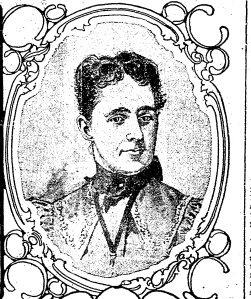
Clara Potter, circa 1902
The Potters lived on Mill Street at the corner of present day Ryder Lane. The house was given to Clara and her sister by their grandmother. Clara would later convince her husband to buy out her sister’s share of the house and sign it over to her making her the legal owner. She was often left home with the children when Charles was working at the Tremont Station in Wareham for periods of time. While Charles was away, Clara made visits to comfort her friend, Jennie McAllister, who lived next to the Collins place and had lost her 17 year old daughter to suicide in February of 1902.
During these visits Clara became friendly with James McDonald. Their familiarity grew and went beyond casual chats at the Collins place. Soon they were going to the theater together and McDonald took her for afternoon drives. In February 1902, McDonald left the Collins place after having “trouble” with Joe Collins. McDonald seems to have accepted an offer from Clara to rent out a room in her house.
Charles Potter did not seem to be aware of his wife’s relationship with McDonald and he agreed with the idea of taking in a boarder, at first. McDonald, not having employment, offered to pay his board as soon as he got a job. Once he got a job McDonald said, he promised to pay for his board and move out.
There weren’t many opportunities for employment over the winter, but as spring came, McDonald began to explore job options. He liked the idea of being a skipper of a yacht. But when he was offered a job as a yacht skipper, he turned it down, citing his lack of knowledge of the local coast line. He also though he could rent a shack near Joe Collins’ place and run a “road barroom”, but decided against it. He had other job opportunities, but passed them up as well.
McDonald claimed he was only a boarder from February to July of 1902. After that, he and Clara entered into a partnership in running a boarding house in which they mostly had transients and no long term boarders. Charles claimed his wife and McDonald were planning on opening an eatery, but questioned the type of customers they would attract noting “the people of Marion are not going to a lunchroom on the outskirts of the village”.
Charles and Clara’s relationship was strained. They got in arguments over McDonald living at the house and his lack of finding work. Charles ate dinner with the kids while Clara and McDonald ate alone together.
Rumors began to circulate that McDonald was selling liquor at the Potter house. Marion at the time was a “no license town”. Other rumors that circulated around town was that McDonald was often seen in the company of girls “not yet out of their teens” and being “unduly familiar” with the young ladies. Tensions were running high in town with some complaining to town officials, but selectmen claimed there was not much they could do. Clara was the legal owner of the house and there was no proof of the illegal selling of liquor out of the house.
In early August, Charles came home from work to find beer and booze in the house. He had enough. He told McDonald to get out. McDonald refused.
“Who’s running this place”? Charles demanded.
McDonald said he was. Charles’ wife sided with McDonald.
“I would have grappled with him then but he is a good deal larger than I…” Charles recalled. He let the matter drop for the moment.
Not long after his argument with McDonald, Charles came home from New Bedford late one evening and found a horse hitched at his house. He walked in the door to find several men in his home “carousing”. Charles announced that who ever owned the horse to get it out of the yard since it was awaking the neighbors. He then began arguing with McDonald and told him once again to leave. Charles decided size no longer mattered and began to “grapple” with McDonald. The fight didn’t last long. Clara opened the front door and McDonald threw him out.
For the next couple of nights, Charles and two of his children stayed across the street at the home of David and Mary Faunce while he pondered his next move. He decided that he would place the children in the care of Jennie McAllister while he stayed with George Gifford. He wasn’t sure what to do next. Charles felt he was over powered and outnumbered in his own home.
He didn’t know that the next move was being planned on his behalf. On the night of August 7, Charles just sat down for dinner when there was a knock on the door. A man that Charles may or may not have known was there to inform him that a group of men were meeting at town hall at 8:00 PM to run McDonald out of town. As Charles later explained it, “I went to see the fun”.
At town hall Charles saw about 50 men had gathered, all wearing hooded masks or handkerchiefs covering their faces. The men made their way through the woods to the Potter house with additional men joining the party along the way. At the house, Charles counted perhaps 100 men who had joined the mob. Five of them walked up to the front door and knocked. One of the men asked for a beer. McDonald opened the door just slightly and the men kick in the door and forced their way inside.
McDonald grabbed a chair and held it up in defense. He yelled for Clara to get his revolver. It was too late. Some of the men grabbed Clara while the others wrestled the chair from McDonald. The men dragged McDonald and Clara into the yard. Clara screamed “Murder!” She begged them to let her stay with her child that was still in the house. One of the men told her not to worry. He would stay with the child.
McDonald and Clara were taken to a nearby sandpit. McDonald was thrown to the ground and his clothing was torn off. He was blindfolded and his hands bound. Using whisk brushes they painted pine tar all over him and then brought out a feather tick bed. They opened the tick bed and dumped the feathers on him.
While the tarring and feathering was taking place a man carrying a lantern told the two men that were holding Clara to take her back home. One of the men grabbed her by her by her collar and led her back home. Outside the house one of the men tore open Clara’s clothing at the waist. The other man tore the hooks off her skirt and let it fall to the ground. The string of her underskirt was broken and her underclothing removed.
All the while Clara pleaded with them not to take her clothing off. They slapped her and said “Shut up”.
“I won’t shut up. Don’t you take off my clothes”, she pleaded.
She tried to scream out. One of the men placed his hand over her mouth. The other placed his hand on her. “If you say anything about this we will hang you”.
She pleaded with them to let her go in the house.
“Will you behave yourself after this?” one of them asked.
She answered that she always did. They hit her again and told her to shut up.
At that point another man came up to them and called for the lantern one of them had been carrying. The man with the lantern left. The other man led Clara up to the house. “If I hear anything from you I’ll hang you. Don’t you dare open your mouth about this.”
He gave her clothing back to her and led her in to the kitchen. Standing there waiting for her was a masked man, a man she would later refer to as Mr. Turner and her husband.
Back at the sandpit the mob tried to place McDonald on a rail post so they could parade him out of town but he could not balance on it. Some of the men went to the house of Selectman Henry Ryder. They asked to borrow his democrat wagon. He let them borrow it. He was pleased to see the matter of Charles Potter’s home affairs being handled though he thought it “was a little rash”.
McDonald was placed on the wagon and several of the men took hold of the shafts and let the cart out to Front Street. They passed Hossea Knowlton’s house and headed for Hiller’s stable. There they attached a horse to the cart and headed back out to Mill Street toward Mattapoisett.
Throughout the ordeal McDonald swore at the mob and planned his revenge. Every once in a while his blindfold would slip or angle at such a way he could see a face. He made mental notes of who he saw.
Once the mob reached Mattapoisett many of the men in the mob took switches and hit McDonald. A rope was thrown over a tree branch. At one end a couple of the men held on while the other end of the rope was placed over McDonald’s neck. The plan was to scare him in to thinking he was to be hanged. But someone had miscalculated the length of the rope. When the men holding the rope realized McDonald was suspended in air they let go and McDonald crashed to the ground.
Charles Potter who had rejoined the mob watched as McDonald ran in to the woods as people yelled at the naked, feathered man to never come back. Charles headed back home thinking it was all over and justice had been served.
The news of what had happened spread quickly. The next day newspaper reporters were in town asking questions. Selectman Ryder said the trouble was behind them. There would be no investigation. “Nobody has complained to the selectman about it”, the reporters were told.
Though local authorities appeared to be turning a blind eye to justice, several sheriff county officers arrived in Marion and arrested five men that McDonald had apparently identified. A week later two more men were arrested in Marion.
District Attorney, Asa P. French who would later be appointed to United States Attorney for the district of Massachusetts by President Theodore Roosevelt, called the act against McDonald “mob punishment” in a town that had always been known to “maintain such a high standard of peace and order, and…always been a law abiding community”.
The men were charged with riotous assault. A fund of $5000 was raised in Marion in defense of the accused. A grand jury indicted the seven men and the case went to trial.
The trial, which began on November 24 was sometimes referred to as the “White Cap” case in reference to a lawless movement called whitecapping that took place in the late 19th and early 20th century in which members of a community formed secret societies that enforced community morals. The movement occurred throughout the US taking on an anti-black theme in the rural south.

Charles Potter on the witness stand, 1902
The trial contained as much drama as the actual events that led to the trial. A witness for the prosecution went missing but was later found and brought in to court drunk. It was thought he had been enticed away by persons supporting the defense and hidden at a hotel in Duxbury. He spent the night in jail to sober up for his testimony.
A witness for the defense was arrested for perjury. The witness, Robert Hiller, testified that he did not see any feathers in the sand pit other than the feathers the chickens were wearing. Deputy Sheriff Hurley and four other witnesses testified they did see feathers and tar at the site.
To add to the drama Charles and Clara Potter and James McDonald were spotted walking “arm in arm to the Potter house” one night and then arriving in the courtroom together. Charles even identified in court several of the accused as taking part in the tar and feathering.
On December 1, both the prosecution and defense made their final arguments. At 4:15 in the afternoon the judge instructed the jury on finding the verdict and adjourned until the jury came back with a verdict. Because of the time it took to hear the case and the charges on each man would have to be discussed by the jury separately nearly all of the court officials and spectators of the trial went home. Though the judge and attorney French stayed in Plymouth, the attorney for the defense, John Cummings, traveled back home to Fall River. There was a lot to discuss and no one expected a verdict for each of the men to be announced anytime soon.
However, just before 1:00 in the morning, the judge was summoned out of bed. The jury had reached a verdict. In a nearly empty court room the jury announced that all of the accused were not guilty. The judge ordered all seven men released, thanked the jury and went back to bed.
The drama with the Potters apparently did not end with the trial. In January, Charles Potter was found unconscious on the side of the road, his faced bruised and bloody. It was believed that Potter had been attacked due to his testimony against the accused and siding with McDonald. Potter claimed that while working that day cutting wood, a limb struck him across the face. While walking home later he said he fainted.
Little is known what happened to James McDonald after the trial. He died sometime in 1905 and he is buried at Union Cemetery in Sciuate. His son, James Henry, never spoke of his father out of the shame he brought to the family.
Clara Potter received a letter from Alabama in 1903 filled with racist comments. The letter writer, W. F. Spurlin, described how southerners “hang and burn” black people and warned her she was not safe in her community and invited her to move south which she seemed to consider. But she did not sell the house and she lived there with Charles until they died. The house is no longer there. The property eventually became part of the Old Landing Cemetery where the Potters lie side by side within sight of where they once lived.

Grave site of Charles and Clara Potter at Old Landing Cemetery, Marion, Mass.

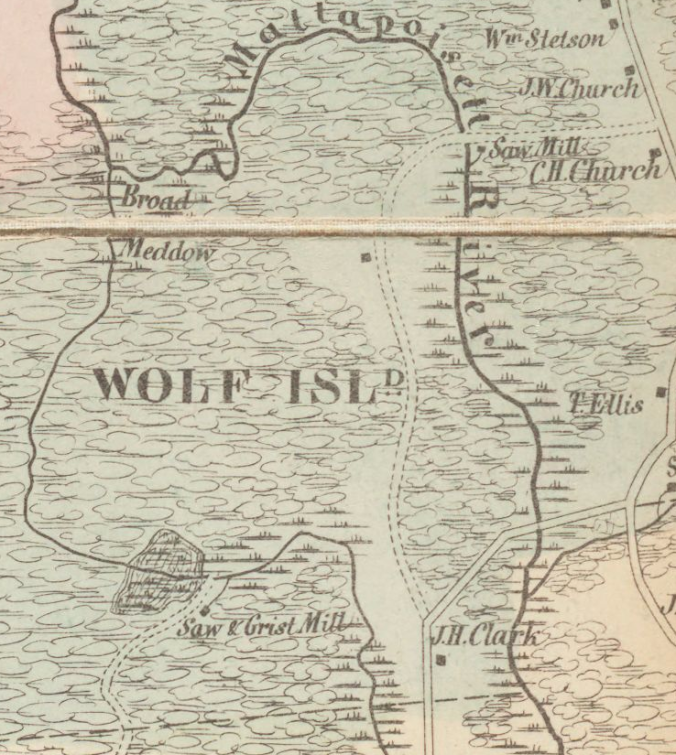









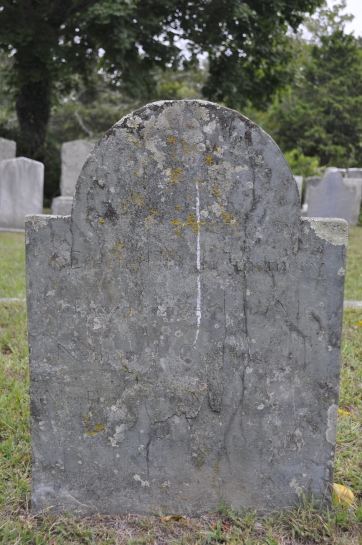 Dedicated to the memory of Mr. Cushing’s two wives, both named Phoebe. It would seem Mr. Cushing married again within days of his first wife dying before he passed away days later. Are the dates possibly wrong on the stone? I was able to verify the dates in the book Vital Records of Rochester, Mass. However, those dates were taken from the stone probably around the time of publication in 1914. The inscription on the stone is hard to read from the photo as well as in person. There is a transcript below. Sadly, it will not be long before it will not be able to be read at all.
Dedicated to the memory of Mr. Cushing’s two wives, both named Phoebe. It would seem Mr. Cushing married again within days of his first wife dying before he passed away days later. Are the dates possibly wrong on the stone? I was able to verify the dates in the book Vital Records of Rochester, Mass. However, those dates were taken from the stone probably around the time of publication in 1914. The inscription on the stone is hard to read from the photo as well as in person. There is a transcript below. Sadly, it will not be long before it will not be able to be read at all.
